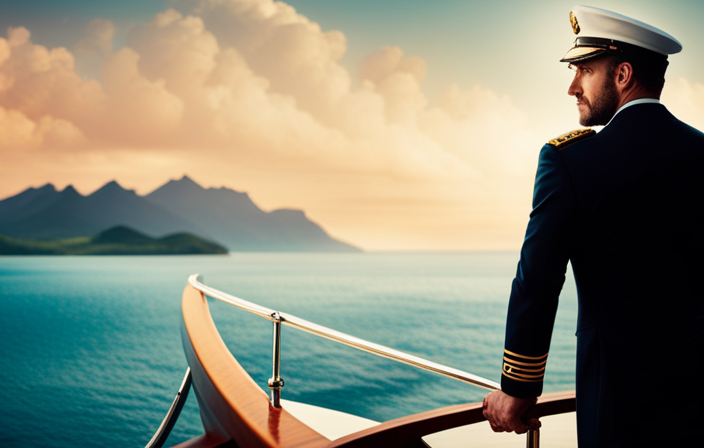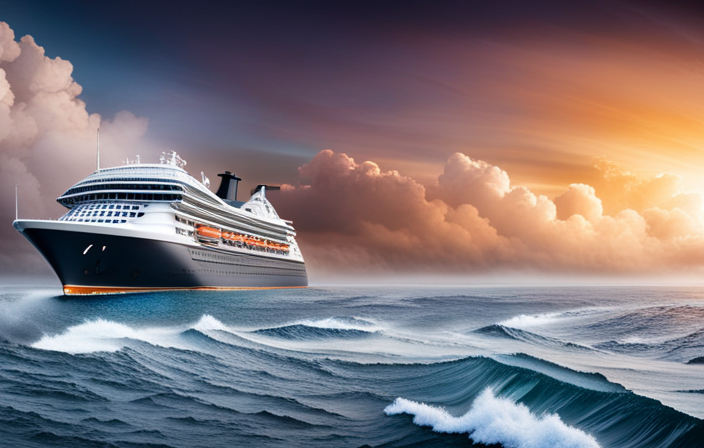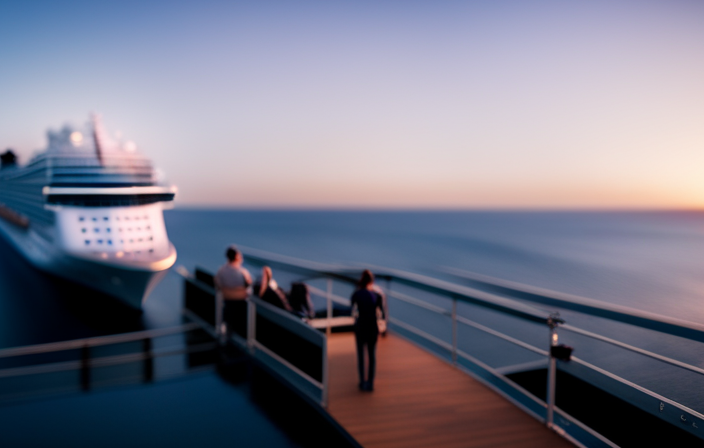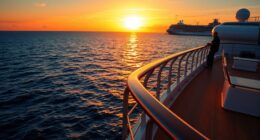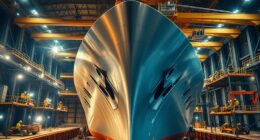It is often said that a ship requires a captain to sail; nonetheless, when it comes to a cruise ship, navigating the expansive oceans is a collaborative effort. Serving as the one in charge of steering, I fulfill the position of captain, serving as the primary leader and authoritative figure in this floating community.
But I am not alone in this endeavor. I have a crew of skilled professionals who work tirelessly to ensure the safe passage of our vessel and the comfort of our passengers.
From navigation officers who plot our course, to helmsmen who physically steer the ship, to engine officers who keep our propulsion systems running smoothly, we all play a vital role in driving this massive floating marvel.
Alongside us, there are maritime pilots who guide us through challenging ports, a bridge team that collaborates to make critical decisions, and automated systems that provide advanced technology assistance.
So, let me take you on a journey behind the scenes, and show you who truly drives a cruise ship.
Key Takeaways
- Maritime pilots play a crucial role in ensuring safe passage through challenging maritime environments and maneuvering large ships within tight spaces.
- Effective communication is essential for maritime pilots, as it provides valuable guidance and instructions during critical moments and enhances safety.
- The responsibilities of maritime pilots include assessing and mitigating potential risks, ensuring the safety of passengers and crew, and contributing to successful and secure voyages.
- The bridge team, which includes the captain and helmsman, collaborates to ensure smooth navigation and safety on board, with each member having specific roles and responsibilities.
The Captain: The ultimate authority and leader of the ship
So, you’re probably wondering who drives a cruise ship, right? Well, let me tell you, it’s the Captain – the ultimate authority and leader of the ship.
The Captain carries significant responsibilities and faces various challenges. They oversee the entire operation of the vessel, ensuring the safety of passengers, crew, and cargo. They make critical decisions regarding navigation, weather conditions, and emergency protocols.
To become a Captain, one must possess specific qualifications and undergo extensive training. They must obtain a captain’s license, which requires years of experience at sea, knowledge of maritime laws and regulations, and proficiency in ship handling and navigation. Additionally, they need strong leadership skills, the ability to remain calm under pressure, and excellent decision-making capabilities.
Now, let’s discuss the navigation officers, responsible for plotting the ship’s course and ensuring safe passage.
Navigation Officers: Responsible for plotting the ship’s course and ensuring safe passage
Direct your gaze towards the skilled navigators who meticulously chart the vessel’s path, guiding it through treacherous waters with unwavering expertise.
As navigation officers, our primary responsibility is to ensure the safe passage of the cruise ship and all its passengers. To accomplish this, we rely on the importance of weather forecasting, constantly monitoring and analyzing weather patterns to make informed decisions.
Additionally, we utilize an array of advanced navigation instruments, such as radar and GPS, to accurately plot the ship’s course. These instruments provide us with real-time data, allowing us to navigate with precision and avoid potential hazards.
By combining our extensive knowledge of maritime navigation with the latest technology, we guarantee a smooth and secure journey for everyone on board.
Transitioning to the next section, let’s now focus on the helmsman, the person who physically steers the ship using the helm or steering wheel.
Helmsman: The person who physically steers the ship using the helm or steering wheel
Take the helm and navigate the waters like a skilled helmsman, guiding the majestic vessel along its course with the precision of a masterful sailor. As the helmsman, my responsibilities are crucial in ensuring the safe and efficient operation of the cruise ship. I am trained to handle the helm or steering wheel, using my expertise to steer the ship in the desired direction. But my role goes beyond simply turning the wheel. I must constantly monitor the ship’s position, taking into account factors such as wind, currents, and other vessels in the vicinity. This requires quick decision-making and a deep understanding of navigation principles. Through extensive training and experience, I have honed my skills to navigate the ship with confidence and accuracy. Transitioning to the chief engineer, let’s explore how they oversee the ship’s propulsion systems and ensure their proper functioning.
Chief Engineer: Oversees the ship’s propulsion systems and ensures their proper functioning
The chief engineer oversees the ship’s propulsion systems and ensures their proper functioning. They are responsible for overseeing the operation and maintenance of all the ship’s propulsion systems, including the engines, propellers, and any auxiliary systems. Regular inspections are conducted to ensure everything is running smoothly. If any issues arise, the chief engineer troubleshoots and coordinates with the engine officers to carry out necessary repairs and maintenance. The engine officers play a crucial role in maintaining the ship’s engines and are an integral part of the team that keeps the cruise ship moving efficiently.
Engine Officers: Assist the chief engineer in operating and maintaining the ship’s engines
Engine officers, with their expertise and assistance, ensure the efficient operation and maintenance of the ship’s engines. In the engine room, these officers oversee all aspects of engine operations and maintenance procedures. Their role is critical in ensuring the smooth functioning of the ship’s engines, which are essential for propulsion and power generation.
To give you a better understanding of their responsibilities, let’s take a look at a table summarizing some key tasks performed by engine officers:
| Engine Room Operations | Maintenance Procedures |
|---|---|
| Monitoring engine performance | Conducting regular inspections |
| Operating engine control systems | Performing routine maintenance |
| Troubleshooting engine issues | Overhauling engine components |
| Ensuring compliance with safety regulations | Repairing faulty equipment |
| Coordinating with other departments | Implementing preventive measures |
These highly skilled professionals play a crucial role in maintaining the ship’s engine efficiency and reliability. Their knowledge and expertise contribute to the overall smooth operation of the cruise ship.
As we move on to the next section, let’s explore the responsibilities of deck officers who assist with navigation and overall ship operations.
Deck Officers: Assist with navigation and overall ship operations
Deck Officers, like myself, are responsible for assisting with navigation and overseeing the ship’s operations. We play a vital role in ensuring the safety of the vessel and coordinating with other departments. Our expertise in navigation systems and protocols allows us to efficiently guide the ship through any weather conditions or navigational challenges. We also implement bridge technology and communication protocols to ensure smooth operations. With our knowledge and precision, we ensure that every journey is executed seamlessly.
Crew Members: Support the ship’s operations and provide services to passengers
Now it’s time to explore the dedicated crew members who keep everything running smoothly and ensure that your experience on board is nothing short of exceptional. The crew dynamics on a cruise ship are essential to passenger satisfaction.
From housekeeping to food service to entertainment, each member plays a crucial role in creating a pleasant and unforgettable voyage. The crew members work tirelessly behind the scenes, ensuring that the ship is clean, well-maintained, and fully stocked.
They are trained to be attentive, friendly, and professional, always ready to assist passengers with any requests or concerns. Their commitment to providing top-notch service is what sets a cruise ship experience apart.
As we delve into the next section about maritime pilots, it’s important to recognize the invaluable contributions of the crew members who make your journey extraordinary.
Maritime Pilots: Local experts who guide the ship through challenging ports and waterways
When navigating through treacherous ports and waterways, you’ll be grateful for the expertise of maritime pilots – the local masters who skillfully guide the vessel to its destination. They possess a deep understanding of the specific port they operate in, including currents, tides, and navigational hazards. With their extensive knowledge, they ensure safe passage through challenging maritime environments.
Maritime pilots are well-versed in the intricacies of maneuvering large ships within tight spaces, such as narrow channels or crowded docks. They have the port expertise required to navigate these challenging areas with precision and skill.
Effective communication is a crucial aspect of a maritime pilot’s role. They effectively communicate with the ship’s captain and crew, providing valuable guidance and instructions during critical moments. This ensures smooth coordination and enhances the safety of the entire operation.
Risk management is another key responsibility of maritime pilots. They assess potential risks and develop strategies to mitigate them, ensuring the safety of passengers, crew, and the ship. Their expertise in identifying and managing risks is essential for a successful and secure voyage.
With their local knowledge and port expertise, maritime pilots play a crucial role in the safe navigation of cruise ships. Transitioning to the subsequent section, the bridge team is a collaborative group of officers and crew members who work together on the ship’s bridge.
Bridge Team: Collaborative group of officers and crew members who work together on the ship’s bridge
The bridge team is a cohesive unit of officers and crew members who work together on the ship’s bridge. They collaboratively ensure smooth navigation and safety on board. Bridge team collaboration, communication, and teamwork are essential for the successful operation of a cruise ship.
Each member of the bridge team has a specific role and responsibility. The captain oversees the overall operation, while the helmsman steers the ship. By working together, they effectively navigate through challenging ports and waterways, ensuring the safety of both passengers and crew.
The bridge team relies on clear communication and constant coordination to make informed decisions and respond quickly to any potential hazards. This collaborative effort creates a strong and efficient team that ensures the smooth sailing of the ship.
It is important to note that in modern ships, advanced technology and automated systems assist with navigation and steering.
Automated Systems: In modern ships, advanced technology and automated systems assist with navigation and steering
In modern ships, advanced technology and automated systems assist with navigation and steering. These cutting-edge systems revolutionize the way ships are operated, ensuring safer and more efficient voyages. Here are four key ways in which advanced technology and automated systems enhance navigation and steering:
-
Precision: Automated systems use advanced sensors and algorithms to calculate precise positioning and course corrections, eliminating human errors.
-
Integration: These systems integrate data from various sources such as GPS, radar, and weather forecasts, providing real-time information to support decision-making.
-
Collision Avoidance: Automated systems continuously monitor the ship’s surroundings, detecting potential collision risks and issuing alerts or even taking evasive actions when necessary.
-
Efficiency: By optimizing routes, fuel consumption, and speed, automated systems help reduce costs and environmental impact.
Thanks to advanced technology and automated systems, navigation and steering on modern ships have become more accurate, reliable, and streamlined than ever before.
Frequently Asked Questions
How many crew members are typically on board a cruise ship?
Typically, a cruise ship has a large crew consisting of various roles and responsibilities. These crew members handle tasks such as navigation, guest services, housekeeping, entertainment, and safety, ensuring a smooth and enjoyable experience for passengers.
What qualifications and training are required to become a captain of a cruise ship?
To become a captain of a cruise ship, extensive qualifications and training are required. This includes obtaining a master’s license, completing maritime courses, gaining years of experience at sea, and demonstrating strong leadership and navigational skills.
How do navigation officers communicate with each other and with the captain during the ship’s journey?
During a ship’s journey, communication between navigation officers and the captain is crucial. We utilize various communication methods, such as radios and intercom systems, to stay connected and exchange important information. However, challenges like distance and weather conditions can sometimes affect our ability to communicate effectively.
Can automated systems completely replace the need for human operators in steering and navigation?
Absolutely not. While automated systems have their advantages, such as increased accuracy and efficiency, the disadvantages of relying solely on them for steering and navigation are far too great. Human operators bring crucial judgment and adaptability to the table.
In what situations would a maritime pilot be needed to guide a cruise ship through ports and waterways?
Maritime pilots are needed to guide cruise ships through ports and waterways when safety precautions and navigation challenges arise. Their expertise ensures smooth navigation in challenging environments, minimizing the risk of accidents or incidents.
Conclusion
In conclusion, the driving force behind the smooth sailing of a cruise ship lies in the capable hands of a diverse team. From the Captain, the unwavering leader, to the Navigation Officers, the masters of course plotting, each member plays a vital role.
Together with the Helmsman, Chief Engineer, and Engine Officers, they ensure the ship’s propulsion and navigation are flawlessly executed. Supported by crew members and guided by Maritime Pilots, this collaborative Bridge Team commands the vessel with precision and expertise.
With the aid of advanced automated systems, they orchestrate a symphony of safety and comfort, guiding passengers to unforgettable destinations.

